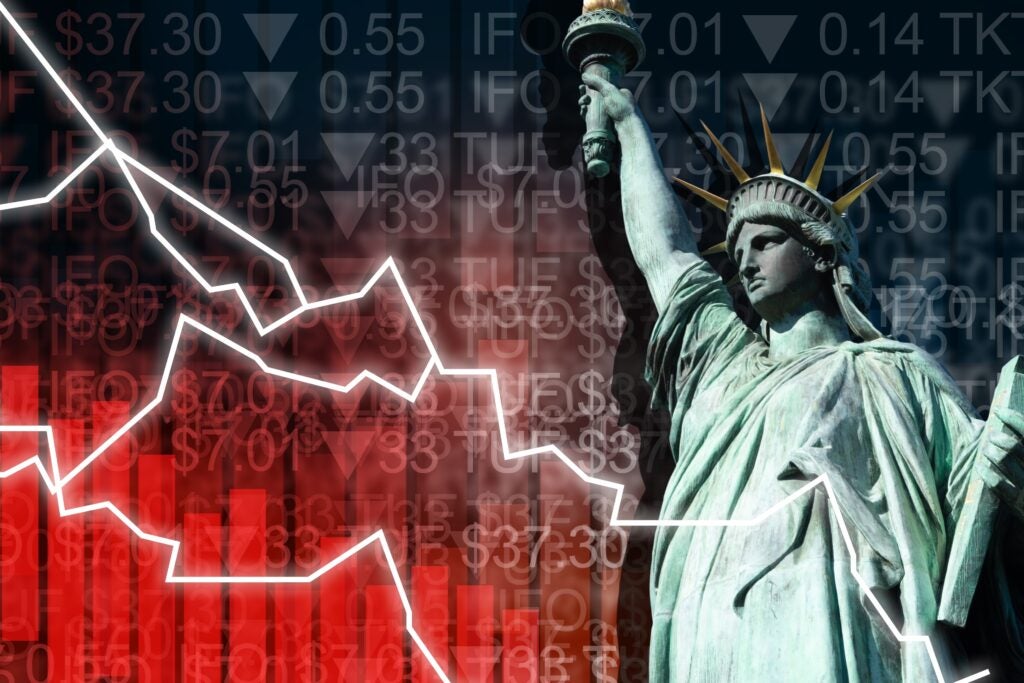
The U.S. economy faces a growing list of headwinds that could threaten growth and stability in 2025. Persistent tariff pressures, rising borrowing costs, low consumer confidence and the resumption of student loan payments each has the potential to slow growth and disrupt economic stability.
Here are 10 key downside risks Dr. Torsten Slok, chief economist for Apollo Global, identified this week.
1. Moody’s Downgrade Raises Borrowing Cost
- Last week, Moody’s cut the U.S. long-term credit rating from Aaa to Aa1, which made borrowing more expensive for consumers and businesses and put pressure on spending and investment.
2. Weakening Housing Demand
- Higher mortgage rates are dampening demand for homes and slowing down one of the U.S. economy’s key growth engines.
Read Next: Solar Energy Stocks Drop As House Approves Major Rollback Of Climate Incentives
3. Tariffs Cutting into Corporate Earnings
- President Donald Trump recently reduced many of the originally steep tariffs he announced on “Liberation Day,” but the average tariff rate remains elevated. The higher levies are squeezing company profits, especially for firms reliant on imported goods and global supply chains.
4. Trade Deal Uncertainty and Retaliation Risk
- Though most reciprocal tariffs have been “paused” and reduced to a baseline of 10% for 90 days to allow for negotiations, few permanent deals have been reached. China and the U.S. would have to agree on a more permanent solution soon as the pause is set to expire in mid-August.
5. High Uncertainty Weakening Corporate Confidence
- Businesses are facing extreme uncertainty, making it difficult to plan and invest, which could slow economic activity. JPMorgan CEO Jamie Dimon said businesses are in “wait and see” mode and are postponing hiring, expansions and M&A deals while the future remains uncertain.
“People have to adjust to this new environment,” Dimon said.
6. Consumer Spending Hit by Higher Prices
- Rising prices at retailers are causing consumers to cut back on spending. Walmart CEO Doug McMillon told analysts on the company’s earnings call on Thursday that the retailer will be raising prices on some items as a direct result of ongoing tariffs.
Read Next: Wolfspeed Stock Plunges 59% On Bankruptcy Fears: Options Traders Cash In
7. Historically Weak Consumer Confidence
- Consumer sentiment is dropping drastically and raising concerns about future demand and economic resilience. The University of Michigan’s May consumer survey showed that sentiment among American consumers has plunged to the lowest levels since June 2020, while expectations for inflation surged to heights last seen in the early 1980s.
8. Lower Tourism
- A decline in visitor arrivals from key regions is negatively impacting airlines, hotels and restaurants, according to the Apollo economist.
9. Student Loan Payments Restarting
- The end of the COVID-19 pandemic-era pause on student loan payments is expected to strain household budgets and reduce discretionary spending. The U.S. Department of Education resumed collections on defaulted federal student loans in May, and according to data from the DOE, more than five million borrowers are in default.
10. DOGE Government Worker Layoffs
- Layoffs of federal employees and contractors could lead to higher unemployment and reduced consumer spending, with ripple effects across the economy, according to Dr. Slok.
Read Next:
Photo: Shutterstock
Market News and Data brought to you by Benzinga APIs
© 2025 Benzinga.com. Benzinga does not provide investment advice. All rights reserved.